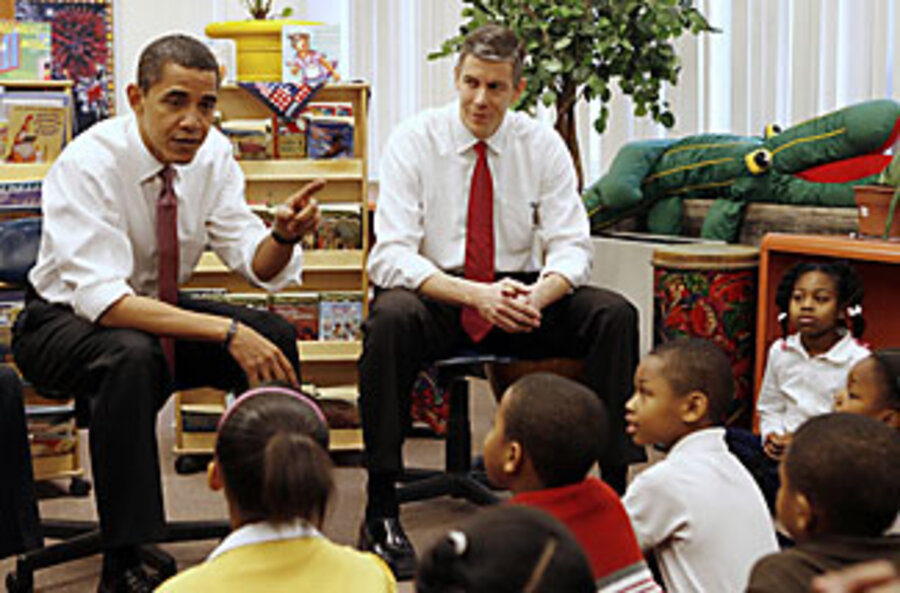For Obama, split looms over education reform
Loading...
With the selection of Arne Duncan as the next secretary of Education, President-elect Obama has chosen a diplomatic reformer. As head of Chicago's public schools since 2001, Mr. Duncan has tried some versions of merit pay and has opened more than 75 new schools, many of them charters, to replace low-performing schools. Such moves generated some tensions with the teachers unions, but he's been able to work collaboratively with them.
Duncan spoke of education as "the civil rights issue of our generation" at a press conference in a Chicago school on Tuesday. But how to do right by children on the low end of academic achievement – who are disproportionately from minority groups – is hotly debated, even among Democrats. His ability to bring people of differing views together will be tested when Congress weighs what to do with No Child Left Behind, the federal law governing much of elementary and secondary education that has been overdue for reauthorization since 2007.
"What remains to be seen is how [the new administration] will come down on accountability – on this question of what is the appropriate federal role in making school achievement transparent and [in] intervening in schools that aren't making the grade," says Michael Petrilli, a vice president at the Thomas B. Fordham Institute in Washington, a research group that supports standards and school choice. "That's really where the fault lines are."
Leading up to Duncan's nomination, a divide grew between Democratic camps.
One side wants to continue the push for accountability via standardized testing – applying it not just to schools but also to individual teachers. It wanted the Education secretary post to go to someone like Joel Klein or Michelle Rhee, who have butted heads with teachers unions as the heads of New York City's and District of Columbia's schools, respectively.
The other side – with which teachers unions are more typically aligned – argues that student achievement gains depend on bringing greater resources to schools and addressing poverty beyond school walls because of its impact on children's health and learning. The resource-focused proponents rallied more around Stanford scholar Linda Darling-Hammond, who led Mr. Obama's education transition team.
National commentators depicted the debate "as an epic battle" between reformers and anti-reformers, which "was worse than a comic-book version of what's going on," says Claus von Zastrow, executive director of the Learning First Alliance, a coalition of education groups including parents, administrators, and unions. Substantive differences do exist, but whether the schism persists will depend on who fills other Education Department slots and what stance the Obama administration takes on specific policies, he and others say. By choosing Duncan, Mr. von Zastrow says, "Obama is setting the stage for a more constructive kind of national conversation on public schools."
Democrats for Education Reform (DFER), a political action committee in New York that stirred up debate at the party's convention this summer, in November touted Duncan as the best choice. It credits him with improving an urban school system viewed as one of the worst a decade ago – by fostering entrepreneurship in charter schools and teacher training, and by shutting down bad schools despite some neighborhood resistance.
"These are some of the most promising efforts to save public education right now," says Joe Williams, DFER executive director, noting that they have not undercut public schools as critics had feared.
Both major national teachers unions have applauded Duncan's selection, while at the same time emphasizing the need for greater federal funding to help close achievement gaps. "Even though there will be times ... that we will differ on methods," says American Federation of Teachers President Randi Weingarten, "the bottom line is we need a secretary of Education ... [who] works with us and others to help every child get a rigorous, well-rounded education.... And that is what Arne Duncan has done in Chicago."
Chicago students have shown some strong gains under Duncan. The percentage of elementary students meeting state standards increased from 38 percent to 65 percent during his tenure. But results at high schools give less to cheer about: Test scores have stagnated, with just under 30 percent of students meeting standards, according to Catalyst Chicago, a newsmagazine that reports on education reform. A change in testing procedures, moreover, has muddied the year-to-year comparisons, Catalyst notes.
The district closed, replaced, or overhauled the management at more than 60 low-performing schools. But Catalyst found that, early on, only a small percentage of students displaced by school closings ended up at the new and improved schools. Many landed at other schools that were on academic probation.
Duncan pushed Education Secretary Margaret Spellings to give his district flexibility under No Child Left Behind – such as allowing it, rather than just outside providers, to offer tutoring to struggling students, but he also earned her praise as a fellow reformer. Under Duncan, the Education Department will be even more willing "to let local leaders on the ground have [that] kind of flexibility," Mr. Williams says.
Many teachers and administrators from around the country say they haven't been heard during the Bush administration, and "people who were angry with Bush got angry with NCLB," says Jack Jennings, president of the Center on Education Policy, a research and public-school advocacy group in Washington. Before Duncan takes action on the law, he says, "it would be a good idea if [he] spent six months just listening."





